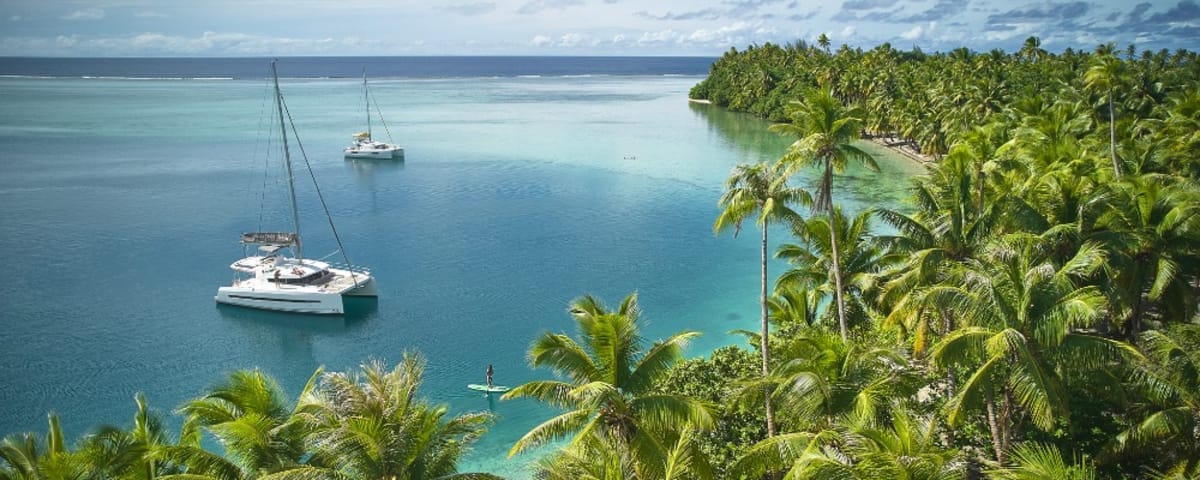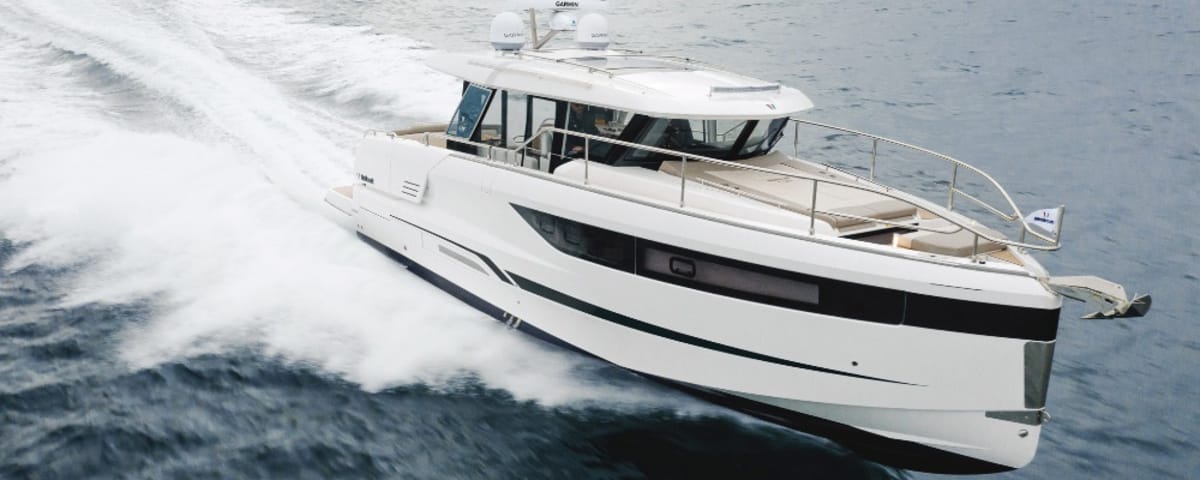Sails: The Boat’s Engine
On long voyages, sails are the boat’s engine. The sails provided as standard on a production boat are not always suitable for long crossings. There are many choices of fabrics, and it is sometimes difficult to know which one to choose. That’s why it’s important to discuss your project with your sailmaker (program, navigation area, budget). On most cruising sailboats, the fabric used is a polyester, which can sometimes be a Dacron (a brand name for a fiber manufactured by Dupont de Nemours). This high-tenacity fiber, which gave very good quality to sailcloth, has been so successful that it is now wrongly used to name all polyester sailcloth. It is therefore important to know if your sail is made of Dacron, a high-tenacity fiber, or simple polyester. For example, Sailonet exclusively uses high-tenacity Dacron fiber (AP) supplied by Dimension Polyant, as well as Hydranet. This is a fabric developed and produced exclusively by its supplier, Dimension Polyant. It is a blend of Dacron and Spectra woven fibers, perfectly suited to the demands of long-distance cruising (resistance to mold, folding, longevity, etc.). There is also Pro Radial, which is a good compromise because its durability and weight are comparable to those of a polyester laminate, and it is resistant to tropical conditions. It is more expensive than a high-tenacity Dacron or a polyester laminate, but less expensive than a Hydranet.
Ropes: Choosing Them According to Use
There is no universal rope. Some require minimum elongation, such as halyards, while others must be able to stretch to absorb shocks, such as mooring lines. Approximately 300 m of ropes are used on a 12 m sailboat, which represents a significant budget.
Ropes for Mooring Lines and Docking
The material that presents the four essential points: elasticity, flexibility, resistance, non-floating is polyamide. It can reach an elasticity of 40% before breaking. The best known is the 3-strand, it is flexible, resistant and easy to splice. Its disadvantage is the formation of kinks. Polyamide ropes have evolved. There are 8-strand ropes (Squarline) that can be spliced directly onto the chain and used directly on the windlass gypsy. In rough ports, to avoid the use of shock absorbers, you can take 24-strand braid (Flatline).
Halyards and Sheets: Minimum Elongation
Here, elasticity is not sought, but minimum elongation. On cruising boats, halyards are made with a parallel fiber core (polyester) covered with a braided sheath (polyester). For long-distance cruising, a braided Technora core is recommended. Sheets must be flexible, pleasant to handle and have a good grip on winches and clutches. The product that best meets these criteria is made with a 3-strand cabled sheath (polyester) covered with a 24-strand braided sheath in discontinuous polyester (cottony appearance).
Some Advice
Avoid making knots. A simple knot, depending on the material of the rope, causes a loss of between 35 and 50% of resistance, or even 80% on Dyneema or Aramid. With a long splice, the loss is 15 to 20%.
A rope gets loaded with salt and dirt. At stopovers, wash them with fresh water with a jet. Do not use a high-pressure cleaner or even a washing machine, otherwise the fibers will break.
If you opt for exotic fibers, which are more efficient (less elongation) and more resistant at equal diameter, you must check that your clutches are well adapted. The same applies to the diameters of the returns (sheaves, pulleys).
DIY stores offer ropes that have the appearance of those used in marine, but for lack of knowing the composition, they may be poorly adapted. A tip, take them in a specialized store by checking origin and technical characteristics.
Pulleys
On a long-distance cruising boat, at least thirty are present. There is no universal pulley. Several criteria must be taken into account to choose the model that best suits a given function.
The Different Technologies
The most representative models are those with friction, balls and rollers, with different combinations in each family.
The simplest is the friction pulley. It consists of a sheave that rotates on an axis. Depending on the models, the sheave can be made of plastic or composite material and the axis of stainless steel or bronze. A simple design that allows to obtain pulleys that can withstand heavy loads to the detriment of speed (friction of the sheave on the axis) to resume a maneuver. To improve the latter, there are models with a lateral raceway that ensures rotation under low load. For the speed of maneuver, the ball pulley is the one that gives the best results. But, be careful, it is made to turn, not to stay under load as for a halyard return. In this case, the balls will quickly deform. To avoid deformation of the balls under static loads, the balls can be replaced by rollers.
Our Advice
For static returns (halyards, boom vang, tackles) friction pulleys are the most suitable and those that have good durability. For quick recoveries that do not remain under load, balls are recommended or even rollers if the loads are important.
For the choice, refer to the manufacturer’s catalog which indicates the diameter of the rope and the loads (working/breaking), for example rope of 10/12 mm, load 1000/1500 kg. Often the recommended use is indicated.
Have an opening pulley on board, it allows to take up a rope under tension or even to temporarily replace a defective pulley.
When a maneuver is not used, for example a spare halyard, do not leave the pulley under load at the risk of ovalizing its sheave.
Winches
You must have on board what is necessary to maintain them (suitable grease) and a pawl/spring kit. If all your winches are manual, you can opt for an electric winch handle.
Windlass and Anchoring
When cruising, we do a lot of wild anchoring. Raising the anchor by hand is inconvenient, with a manual windlass it is long and, in many cases, it must be raised quickly (boat that hunts, risk of collision, etc.). The solution, the electric windlass. A big consumer of current, yes, but it is compensated by the engine. The choice of the chain is essential. You must choose a diameter adapted to the windlass gypsy. As for the material, galvanized steel is a good choice. At equal diameter, there are several resistances indicated under the name grade, for example, a 10 mm grade 40 chain has a breaking strength of 6400 kg, one of grade 70 one at 11200 kg. For the rope (mixed mooring) cf. rope. Remains the anchor, there is no universal model that suits all bottoms. But, the different tests and the experience we have, show that those plow shape heavily weighted on the tip are the most effective. Light anchors should be reserved for fair weather anchoring and be used with a leaded rope.
Our Advice
Never use a quick galva link to connect two chains of the same gauge, it’s a fuse. An 8 mm link has a breaking load of 800 kg, a chain of the same diameter (grade 40) one of 4000 kg.
A chain hook helps relieve the mooring, avoid chafing and protect the windlass gearing.
To connect the chain to the anchor, use a chain-anchor joint.
Have two moorings on board with different anchors, for example, plate and plow.
The mooring must always be in place ready to be used.
Shackles and Snap Hooks
For shackles, there are many models on the market with different shapes (straight, lyre, long, etc…) offered in stainless steel, galva, plastic and textiles. Textile shackles are increasingly present. They save weight and avoid noise. But, be careful, only take products made by professionals who indicate the characteristics (use, working load, breaking load etc.).
For snap hooks, we find the same manufacturing materials as for shackles. If jib rings are little used due to the presence of sail furlers, other products have appeared such as snap hooks for straps, with swivels and, for certain functions, textile connectors that can replace them.
Enjoyed this post by Thibault Helle? Subscribe for more insights and updates straight from the source.


